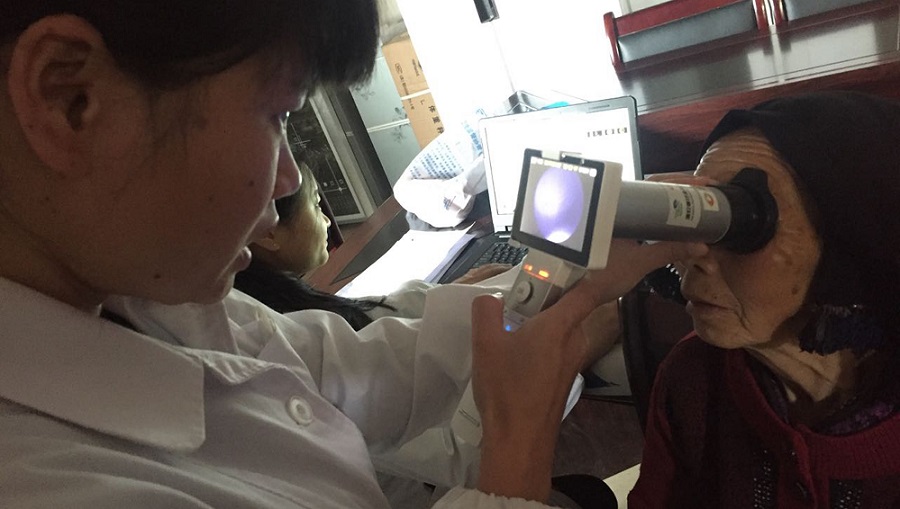Join the Leading Global Eye Health Alliance.
Membership-
Choose an alternate language here

![]()
Patient Access: Piloting Approaches to Reach People with Diabetes for DR Screening in Rural Areas of Yunnan, China
One out of four people with diabetes lives in China. China has the world’s biggest diabetes population with a total of 109.6 million people with diabetes and an estimated prevalence of 10.6% (age 20-79 years)[1]. In April 2016, The Fred Hollows Foundation in partnership with Seeing is Believing Phase V, launched a comprehensive rural eye care model project in the Yunnan Province of China. A core project component is the community-based intervention model for the management and control of Diabetic Retinopathy (DR). Through this model, the project works to build local capacity at the primary and secondary levels for the early identification of DR, initial care and treatment of early stage of DR, and to strengthen the referral pathways from primary to tertiary eye care facilities.
To build comprehensive capacities for DR services from primary to tertiary levels, the project has supported a variety of trainings for eye professionals, endocrinologists, community health workers and PBL management officers across all levels and amongst different departments/divisions. Comprehensive capacities across DR services include health education, screening, referral, treatment and patient management services. In addition to training activities, a grading centre to support the screening and diagnosis for DR was set up at the tertiary partner hospital, including provision of essential equipment and software which allows for auto grading, on-line image transferring and analysis to be undertaken. The software also includes a reporting system that supports DR screening across primary, secondary and tertiary levels partner hospitals and between endocrinology and ophthalmology units.
In conjunction with efforts to build service capacities, the project has also worked to increase community service usage. Community screenings for DR amongst Diabetes Mellitus (DM) patients are conducted at local township hospitals by DR screening teams from prefecture and county partner hospitals. Standardized procedures for community-based and hospital-based DR screenings, as well as the referral pathway between eye and endocrinology departments have been developed and are practiced by all project partners. These procedures and referral mechanisms form a sustainable impact of the program that not only contribute to project implementation efficiency, but also lead to strengthened cooperation between hospital departments.
With no prior experience undertaking community-based DR screenings, project partners experienced a number of challenges with regards to reaching the targeted number of people with screenings. Specific issues affecting screening numbers include large numbers of registered DM patients migrating to other cities for work, and of those remaining, many are older people who generally attend medical services at a lower rate, inconvenient transport in rural areas for people to travel to township clinics, and a lack of awareness of the need for regular eye checks. According to a KAP survey conducted as part of the project, 53.8% of the interviewed DM patients had not had their eye checked in the past 12 months.
To increase the numbers of people with DM reached with DR screenings, The Fred Hollows Foundation is working closely with partners to explore innovative strategies. One such approach undertaken by a number of partner hospitals is to provide additional training to local community health workers on DR prevention, so that they can provide health education on DR, including promotion of DR screening, in the community on daily basis. Prefecture level partners are working with community/township hospitals (who have patient contact information) to phone and text message DM patients in the community to attend DR screenings. In addition, local partners have proactively approached the local HFPC/B (Health and Family Planning Commission/Bureau) for support, with discussions resulting in proposed solutions including the integration of DR screening into quarterly health checks for people over 50 years old and combining screenings (eye, feet, heart, etc.) for diabetic complications as a one-stop service for people with diabetes. HFPC Bureaus in two counties (Binchuan and Qiubei) are now piloting these strategies and showing positive results with regards to increasing the number of DM patients being identified and reached with DR screening. Expansion of these innovative strategies to the remaining four partners (in two counties and two prefectures) is planned to start from January 2018.
Authors:
Ms SHI Zhiping
Project Officer
The Fred Hollows Foundation
Ms WANG Jing
Senior Project Officer
The Fred Hollows Foundation
Co-author:
Ms. Amanda Huang
Senior Program Manager
The Fred Hollows Foundation
[1] IDF Diabetes Atlas, Seventh Edition, 2015